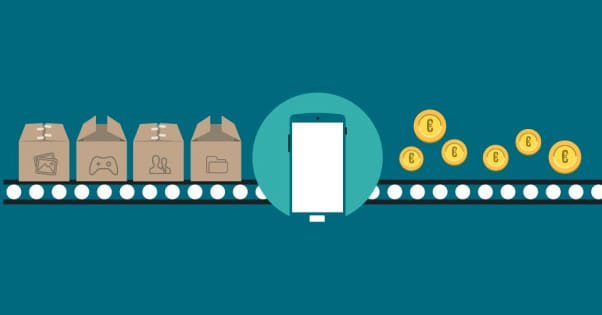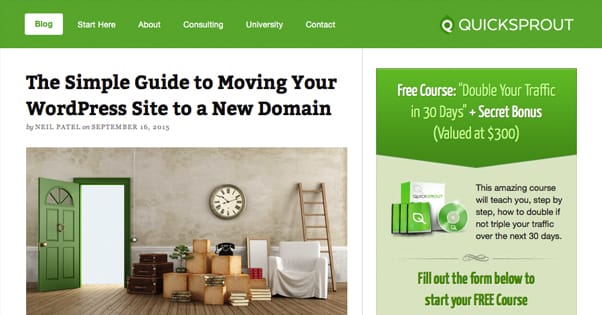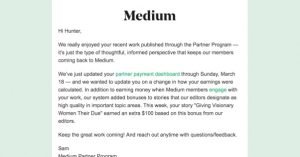What is The Best Way to Start Making Money By Blogging?
Published by Kenny Novak • Content Marketing • Posted September 17, 2015 ContentPowered.com
ContentPowered.com
The work from home dream is, for many, most easily achieved with blogging. If you can write, research, and share your knowledge with the words you write, you can be a successful blogger.
That said, you need to go about it the right way, with knowledge and patience, if you want to succeed. Many of the most successful bloggers out there have stories that begin with “I started blogging in 2005” and “I started making enough money to quit my job in 2011.” Some of them don’t start monetizing until late, but many just take that long to buckle down and do what they need to.
If you want to make money with blogging, you have a ton of options, but many of them will take a lot of investment to get going. You need to be prepared, either by maintaining a day job or other business, or by having the support you need to focus your efforts entirely on building your blogging empire as quickly as possible.
All that is just a fancy way of saying don’t quit your day job to become a successful blogger; it won’t happen fast enough, and the stress of that lack of immediate success will make it that much harder.
Step 1: Make a Blog
When profits are your goal, you want to minimize expenses. That may tempt you into skimping on your blog, but that’s a bad idea. The premier free option is WordPress.com, but they’re very limited and don’t give you the moneymaking potential you really want. In particular, you can’t use most forms of monetization until you have 25K pageviews per month. Instead, splurge a little on a domain name for $10 a year, some web hosting for $100 a year, and some professional graphic design to spice up whatever theme you choose to use. You can handle the writing yourself, of course.
Step 2: Write a Lot of Content
The ideal length of a post, as determined through statistical analysis over the last few years, is 2,500 words. Anything shorter tends to cut you off before you put together enough detail to reach your conclusions in a satisfactory manner.
If you can support it, I recommend 2-3 posts per week to start. This can be a lot of work and a lot of writing, so many part-time bloggers can’t handle it. To help support yourself, it’s generally a good idea to spend some time prior to launching your blog, coming up with topics and writing content. If you can give yourself 3-4 months of content ready to be published before your blog goes live, you have more leisure to handle the monetization right away.
Remember that pretty much every possible means of making money with a blog relies on traffic and exposure. The more posts you have, the more traffic and thus exposure you can get. Every single blog post is an opportunity for success.
One trick to help you build up your content is to intersperse content from other people. On one hand, you can solicit guest posts from prominent bloggers, or even other niche bloggers, who can give you a bit of networking and exposure. On the other hand, you’re also always capable of spending some money to buy blog posts from freelance ghostwriters. Talented writers exists everywhere – most of the content you read online is ghostwritten – but it can be an expense that hampers your productivity and profitability.
Step 3: Build an Audience with Sincere Relationships
Once your blog is live – yes, I’ve glossed over a lot here, but setup and launch isn’t the focus here – you need to make yourself available and social. Share your posts on social media and keep talking to people. Respond to comments. Be a friendly, open person. The relationships you make here will stick with you for the lifespan of your blog.
Step 4: Network with Influential People
This is an extension of the previous step, but it’s also a tie-in to the next one. As you blog, you will attract the attention of influential people in your niche. You can also work to bring yourself to their attention, either directly through email or indirectly through social media or blog comments.
Influential people are able to do two things for you. One is exposure. An influential blogger can give you a huge amount of exposure just with a simple link or share, and if you get on their good site, they can be hugely beneficial over a long time.
The second benefit is the potential for a mentorship. These bloggers have been successful in the same niche as you, doing what you intend to do, and they can give you excellent advice and tips if you ask. Ask! Most people are nice and happy to share their success. There’s no such thing as a trade secret in blogging.
Step 5: Decide on a Monetization Goal
Before we step into monetization methods, decide on your goals. Do you want beer money, supplemental profits, or just enough to cover hosting and domain? Do you want to have enough to splurge a couple of times per year? Do you want to replace your day job, or do it one better? You need to get an idea of how much money you want to make on a monthly basis so you know what style of monetization you should use.
It won’t be hard to make a few bucks a month, even after expenses. It becomes an entirely different ballgame if you’re trying to start a business or quit a day job on the income from the web. Once you get things going, it can be a very consistent and very potent source of income. Until then, though, you have to put in a lot of work.
Step 6: Monetize the Blog Itself
Alright, time for the beefy section. You came to this post to learn what monetization method to use, and that’s what I’m going to give you. I’ll give you a rundown of the options available to you, and you can decide which you want to pursue.
The first category is advertising. There are a lot of ways you can advertise on your blog, but they will generally come down to the same set of systems.
- Display advertising. This can take the form of text ads or banner ads, like AdSense, Beacon, and a bunch of other networks. These will tend to be a “slow and steady” kind of income, since display ads don’t pay much unless you have a ton of traffic. If you’re in a very specialized niche, you might have some high value ads, but don’t count on it.
- Private ads. These are just like display ads, only you aren’t going through a third party network, which take a cut of your profits. The downside is that they take more direct monitoring and maintenance to make work, which is why so many people defer services to ad networks.
A sub-category of advertising, and a side method of making a profit, is through reviews and giveaways. Sometimes, businesses will decide they want to advertise through popular blogs, and will give you the resources to advertise for them. One example is when a business sends out copies of a product for previews and day one reviews. It’s incredible how much stuff PC Magazine is given regularly just to review it. Sometimes they will also give you items to give away, which doesn’t necessarily benefit you directly, but allows you to gain traffic and thus accelerate other forms of monetization.
The second category is sponsorships and sponsored content. This is when your blog is popular enough that you can charge people for the right to advertise on it, through various means.
- One means is through forms of media like a podcast. You can do sponsored product shoutouts before or after the main content of a podcast very easily, and because it’s a lot like a radio show, no one is going to fault you for selling the ad space.
- Another means is through regular communications like a newsletter. People like to receive newsletters from the blogs they follow, and that gives you the chance to sell space in your weekly or monthly newsletters.
- Sponsored posts are another method, but you have to be careful with them. They need to be clearly marked, and they need to be at least as high quality as the usual content on your blog. You may want to minimize links in sponsored content just to avoid Penguin penalties as well.
A third category is affiliate marketing. This comes in two flavors; one time offers and recurring offers.
- One time offers tend to be more valuable, but aren’t necessarily. Small offers rely on volume to make a profit, like earning 60 cents per referral on a phone app. Others are much more lucrative. Find offers in your niche and see what you can promote.
- Recurring offers tend to be content like magazine or website subscriptions, or courses. These have the potential to continually pay you for months or years, and as such tend to pay a little less than the average one time offers.
The key to affiliate marketing is to genuinely review products you like and can recommend. Web users are very astute when it comes to sensing bullshit in sponsored positive reviews, and as such you will have a hard time recommending products you’ve never used.
Another category is selling a digital product yourself. These can come in a wide range of flavors, depending on your niche and your proclivities. It’s also one of the most lucrative options, particularly for long-term profits.
- If you have video or audio production skills, you can create stock music and videos for other people to use in their videos and podcasts.
- If you’re more of a programmer than a writer, you can create apps, plugins, WordPress themes, and a whole host of other related digital products. Just look at everything in the massive Envato Market.
- If you have the skills and knowledge, but not the time to put them to use, you can sell your services as a consultant, tutor, or teacher. Selling your skills is always available, even as a supplement to other forms of monetization.
- If you’re focused on writing, you can supplement your quality blog posts with even more high quality, very lengthy ebooks.
- Some websites – though fewer than in the past – are able to run VIP blogs and communities, where members have to pay to access them. This can be a viable business model, but typically only once you have the audience to support it. Think of it as a late-game strategy.
Next, you can sell physical products. These can also come in many forms, but have certain logistical problems when it comes to selling them. If you’re selling a book, for example, you either need to have space to store a few thousand copies before you ship them, or you need to contract a distributor like Amazon and get your product on their shelves.
- Any ebook can be converted into a high quality book, and print on demand services make it easier than ever before to produce them for consumption. Remember that, while a blog post is 2,500 words and a good ebook might be 10,000, a real book will be closer to 50,000 or more. They are a lot of work to produce, but they can exist and provide value for decades.
- If you have skills and experiences, you can host talks, conferences, and speeches. Look for events that have open enrollment of speakers, and you can start a speaking circuit. Eventually, you can reach a point where you can charge venues for the privilege of hosting you. This does require the proper mindset for speaking, though, which many web-based entrepreneurs don’t’ have and want to avoid.
- Crafts and handmade products are big in certain circles, like eBay and Etsy. If you can quilt, crochet, work metal, or do anything craft with your skills, you can sell the products. In these cases, your blog will become the supplemental product, and will exist to market and promote your products.
- You can also become a product reseller. This is a lot like a combination between selling your own products and affiliate marketing. You can even go on weekly garage sale tours and pick up items to resell for profit, using your blog to chronicle your finds.
Finally, there’s services you can provide. In addition to consulting, which has been mentioned above, you can be a freelancer providing a wide range of services depending on your skillset. In addition to selling yourself through your website, you can set up profiles on freelancer hubs like Upwork and Freelancer.
- Sell your services as a personal or administrative assistant.
- Sell your time as a work from home call center operator.
- Sell your writing as a ghostwriter or as a freelance blogger with name recognition.
- Sell your ability to produce and edit video, audio, or voice work.
- Sell your services as a marketer or social media manager.
With all of these options available to you, there are a million and one ways to make money through blogging. The question is, what’s best for you?
If you’re not looking to make a lot of money, you can get away with display ads or something simple like affiliate marketing. These don’t require heavy physical investment.
If you want to replace a job and go entrepreneur full time, you’ll want to invest in some of the more lucrative options, like skilled services or freelance work.
If you have a lot of time on your hands, you can do some of the more crafty or skill-intensive options, like resales or physical products. I recommend only doing this when you have a lot of resources already available.
You also need to decide if you want your blog to be the focus, or if you want to use your blog as a way to market and promote another business. This will help guide your decision between physical and digital or between skill-based or marketing options.









